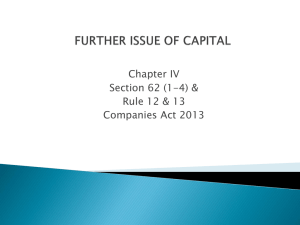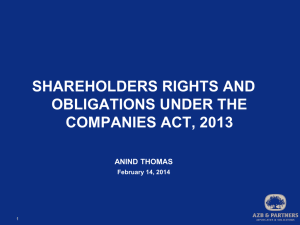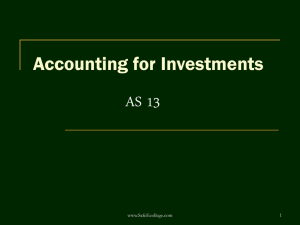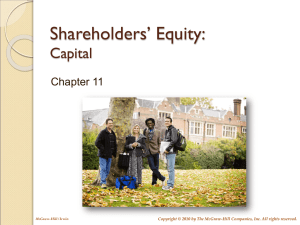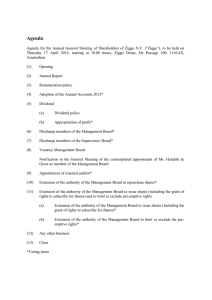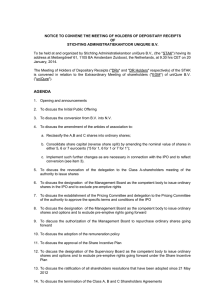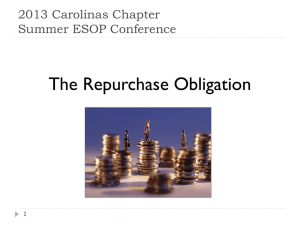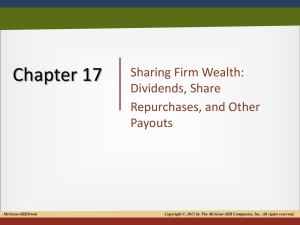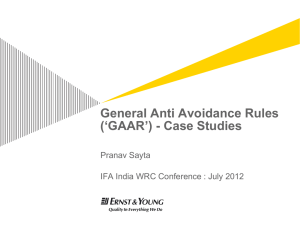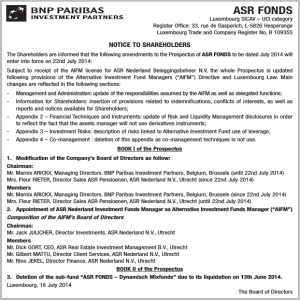File
advertisement
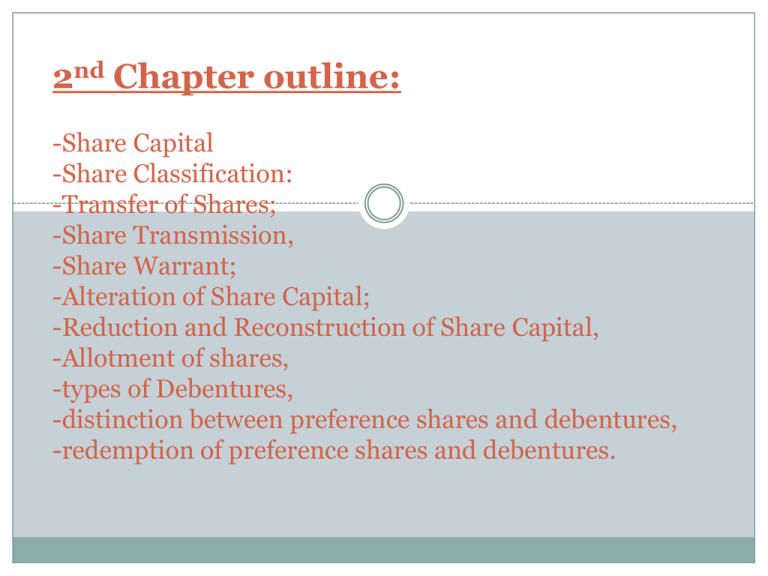
2nd Chapter outline: -Share Capital -Share Classification: -Transfer of Shares; -Share Transmission, -Share Warrant; -Alteration of Share Capital; -Reduction and Reconstruction of Share Capital, -Allotment of shares, -types of Debentures, -distinction between preference shares and debentures, -redemption of preference shares and debentures. Share Capital The owners primary interest invested against shares in the company is what is known as the share capital of that company. The Authorized Share Capital of the Company is Tk. 10,00,00,000/- (Ten Crore) divided into 10,00,000 (Ten Lac) Ordinary Shares of Tk.100/- each with power to increase or reduce the same value of its shares. Authorized capital: The amount of capital with which a company is registered with the registrar of companies (body responsible for registration of companies). It is the maximum amount of capital which a company can raise through shares i.e. shared capital can be maximum up to the authorized capital and not beyond. Paid-up capital: The amount of capital (out of called-up capital) against which the company has received the payments from the shareholders so far. Share Classification 1.Common Stock or Ordinary shares 2.Preferred Stock or Preference Shares Common Stock or Ordinary Shares -A majority of the shares issued by companies are common stock or ordinary shares. -Common stocks rank below preferred stocks in the dividend payments. -While preferred stock holders are assured of dividends, dividends due to common stock holders may be irregular and not of fixed value and sometimes not paid at all. -That is why common stocks are ranked last among the types of shares. However, the largest percentage of shares issued belongs to this type of shares. -During liquidation of a company, remaining asset value is distributed last to the holders of common stocks. -Common stock holders have, however, one major advantage over preferred stocks - that of voting rights. Common stock holders have the right to vote during shareholder meetings as well as the right to vote in the election of the Board. Share Classification Preferred Stock or Preference Shares -As the name implies, a preferred stock has some features of value, which a common stock lacks, and therefore rank above common stacks. -The main feature or preferential treatment for preferred stock lies is in dividend payments. -Shareholders of preferred stock must be paid dividends before shareholders of common stock. -The dividend to be paid the investors owning preferred stocks is usually fixed. Whether the company makes profits or not, usually dividends must be paid to preferred stock shareholders. -Those having preference shares can also choose to carry over their dividends cumulatively to the next years, if the dividends are not paid in the current year. Shareholders of preference stock get precedence even when there is a liquidation of the company, which has issued the shares. - When a company is dissolved or liquidated, first it must pay all its liabilities. The remaining assets after liquidation can be distributed among shareholders, with preferred stock holders getting precedence over common stock holders. A preferred stock is more stable than a common stock due to fixed dividend payments as well as likelihood of appreciation in the value of preference shares. It is ideal for investors who seek regular income with less risk. However, preferred stock holders are often given the option of converting their shares to common stock. Deferred shares: These shares are those shares which are held by the founders or pioneer or beginners of the company. They are also called as Founder shares or Management shares. Deferred shares have disproportionate (unequal) voting rights. These shares have a small denomination or face value. Bonus shares: The word bonus means a gift given free of charge. Bonus shares are those shares which are issued by the company free of charge as bonus to the shareholders. They are issued to the existing shareholders in proportion to their existing share holdings For example. two bonus shares for five equity shares. The issue of bonus shares is also termed as capitalization of undistributed profits. Right share: A rights issue is an issue of additional shares by a company to raise capital under a seasoned equity offering. The rights issue is a special form of shelf offering or shelf registration. With the issued rights, existing shareholders have the privilege to buy a specified number of new shares from the firm at a specified price within a specified time The right has been conferred on the equity shareholders by the companies act 1994, section 155(1) Transfer of shares Shares are movable properties and transferable from one person to another in a manner provided by articles (sec 30-1) Share Transmission Transmission of shares is an involuntary act resulting from the operation of law due to death or insolvency of a shareholder. Share Warrant and share certificate Share warrant can be issued only in respect of fully paid shares. -Example: 100 taka each share and 50 shares lot. Then fully paid 100*50=5000 tk A share certificate is issued in respect of partly paid shares Market lot The nominal value of shares per unit may be of various categories, such as share of tk. 10, tk. 100,etc. but a minimum number of units or lots is also fixed for user convenience , namely 50 shares for the unit of tk.10 Merger The combining of two or more entities into one, through a purchase acquisition or a pooling of interests. Differs from a consolidation in that no new entity is created from a merger. http://www.vakilno1.com/ saarclaw/bangla.html 1. The Companies Act 1994. 2. The Securities & Exchange Ordinance 1969 as amended up to date. 3. The Securities & Exchange Rules 1987 as amended up to date. 4. The Securities & Exchange Act 1993 as amended up to date with publications made by SEC on Public Issue Rules/Right Issue Rules 1998 and others governing securities market. 5. DSE/CSE Rules. BSEC guidelines for share issue 1. public offering 2.greenfield projects 3. pricing of securities 4. prospectus The first guidelines: 1. Public offering: A company may be a public or private company, and formed as a joint venture,100% foreign owned or local owned company. A private company, whether a joint venture or 100% foreign owned or local owned can raise capital 2. Greenfield projects To protect the investors interests, a Greenfield public company is, however, required to comply with certain conditions for the purpose of public offering including the following: 1. 2. 3. 4. 5. sponsors should have a track record of profitability, liquidity and solvency; sponsors should not be bank or tax defaulters; Sponsors must raise their portion of share capital before public offering; The company must acquire land, complete construction of building, open LC, and finalize shipment and erection schedules before public offer; and The company must make financial and physical plans for implementation of the project and ensure that actual conform to the plans. 3. Pricing of securities The justification is required to be given with reference to a) Net asset value per share b) Earning based value per share c) Market price per share 4.Prospectus To obtain SEC’S approval, a prospectus must make full fair and adequate disclosures about the following: - purpose of public offering justification of share price justification for share premium financial forecast and basis and assumptions underlying such forecast actual financial information for the last five years description of the project including capacity, products, country of origin of machinery, technology and management highlights, risk factors and management’s perception about the risk factors. Merchant bank A merchant bank is a financial institution which provides capital to companies in the form of share ownership instead of loans. A merchant bank also provides advisory on corporate matters to the firms they lend to. Manager to the Issue (issue manager) Issue Management Scope of Work as Issue Manager Analysis of the financial and capital structure of the Issuer Company Determination of capital structure and the means of finance thereof e.g., by way of issuing new ordinary shares, or issuing right shares, or issuing debentures, etc. Recommend the changes related to RJSC e.g., Name Change, Denomination Change, Private to Public Limited Company etc. Determination of the size of public offering and offer for subscription through Pre-IPO private placement arrangement if any. Preparation and filing of prospectus to SEC Incorporation of modification suggested by SEC. Obtaining approval from SEC within the stipulated time Preparation of company brief for the Underwriters Selection of underwriters to the Issue Selection of Banker to the Issue Coordination of the post issue work Supervising the distribution of prospectus and application forms to Bankers to the Issue and members of the DSE and the CSE Filing of application for listing with Dhaka Stock Exchange Ltd. (DSE) and Chittagong Stock Exchange Ltd. (CSE) Notwithstanding the above, if any other services required but not listed herein above for the effective PUBLIC ISSUE is perform Underwriter A syndicate of banks (the lead managers) underwrite the transaction, which means they have taken on the risk of distributing the securities. Should they not be able to find enough investors, they will have to hold some securities themselves. Underwriters make their income from the price difference (the "underwriting spread") between the price they pay the issuer and what they collect from investors or from brokerdealers who buy portions of the offering. Prospectus and public issue Section 135 of the companies act 1994 refers to schedule-III which contains the detailed list of some specific requirements as to the prospectus. 1. Name of the company with date of incorporation. 2. Date of the prospectus 3. Consent of the securities and exchange commission

